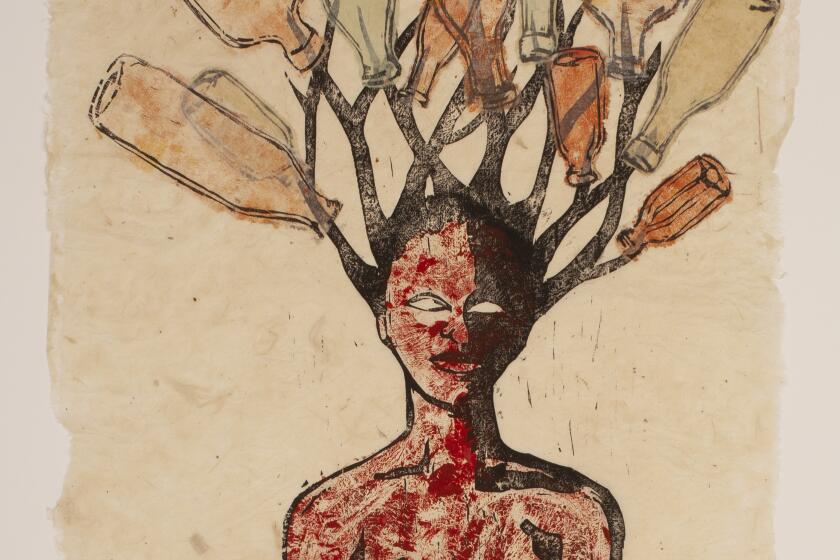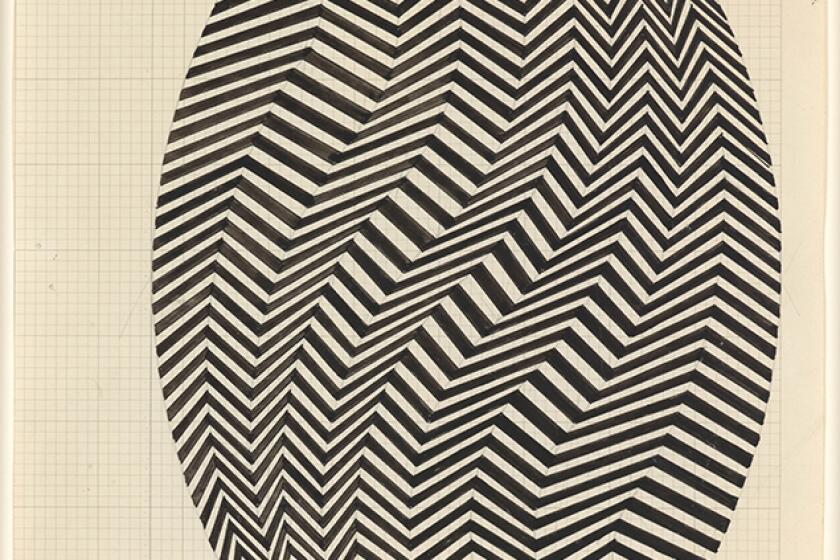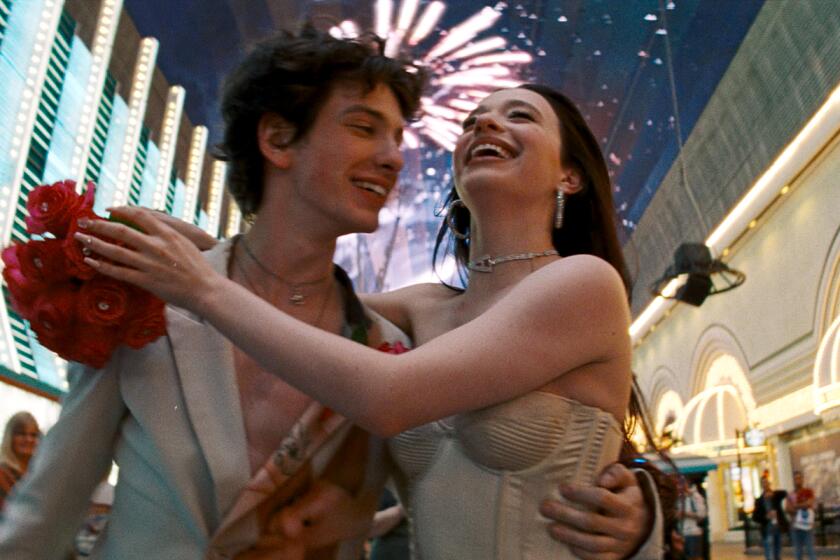Inside the hidden gem of the Hammer Museum’s $90-million renovation
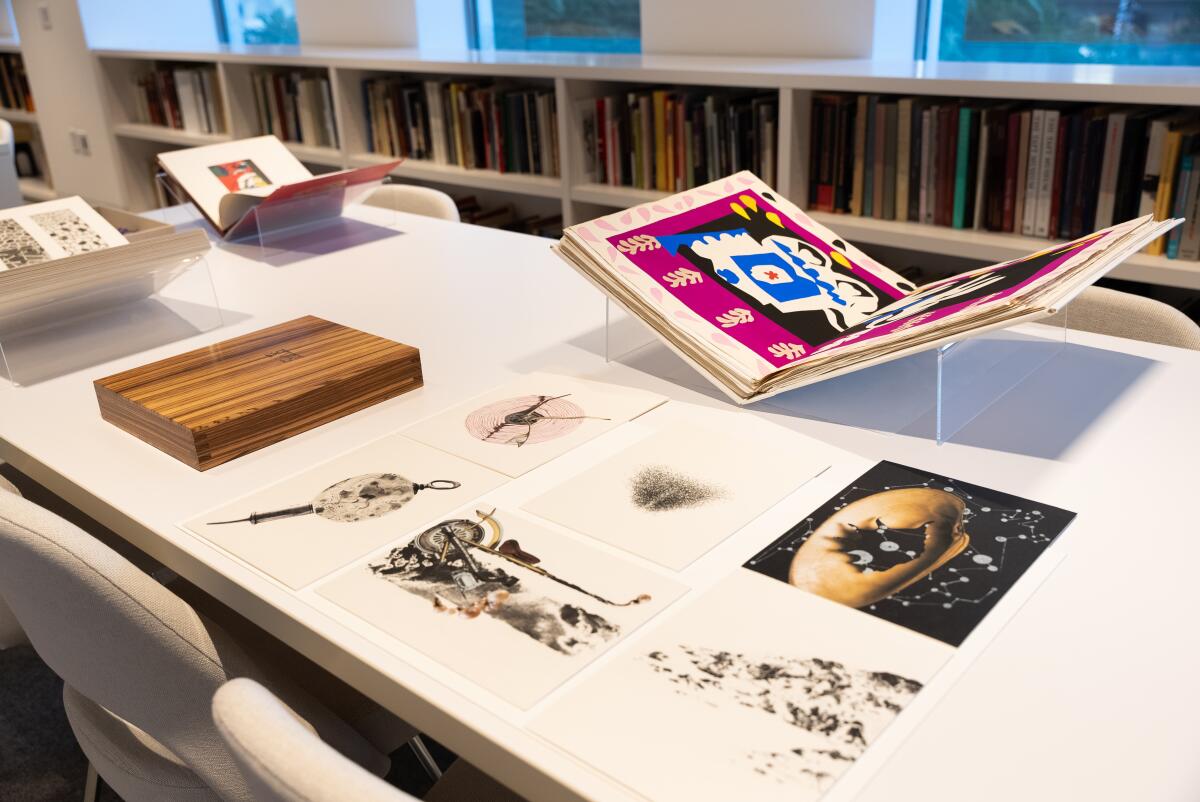
- Share via
About a dozen UCLA students circle the room, riveted by two black and white Ruth Asawa prints.
The artist was incarcerated, as a teen, in a Japanese American detention camp and the works she created tell a tragic story. Each depicts a man, cloaked in a robe, with an amulet around his neck. In one, his eyes are vacant and his expression is obscured by dark ink, suggesting a painful past. In the other, his eyes are piercing and his face luminescent, suggesting an open if optimistic future.
The students lean in close, scrutinizing those and other Asawa works, which lie flat on a table, unframed, or are propped up against a wall. They scribble notes on a clipboard. It’s silent but for the scritch-scratching of their pencil tips, their concentration nearly palpable.
“They’re so different, this one is so dark,” one young woman says.
“I think one is his internal representation, the other’s his exterior,” her friend replies. “The background, the stuff radiating, that could be his trauma.”
This Asian American studies class is not taking place in a classroom or lecture hall, but rather in the university’s Grunwald Center for the Graphic Arts at the Hammer Museum. The students are delving into the renowned collection of prints to spark discussion about “activist legacies from the Japanese American incarceration and related wartime atrocities,” as the course description reads.
The Grunwald collection includes more than 45,000 works on paper — primarily prints, but also drawings, photographs and artists’ books — from the Renaissance to the present day. It’s one of the largest collections of its kind on the West Coast, with strengths in European and American art as well as Japanese prints. While it has areas of great depth — including more than 7,000 prints by 19th century French caricaturist Honoré Daumier and 950 Japanese woodblock prints from the Edo and Meiji periods — the collection is notable mainly for its range. It represents artists working in diverse styles, with a variety of printmaking techniques, and addressing myriad topics over 500 years. So it’s especially suited for study.
As part of the Hammer’s two-decade, $90-million reinvention — designed by Michael Maltzan Architecture and the final phase of which debuts this week — the Grunwald Center now features a new, state-of-the-art study room and an adjacent gallery for works on paper. The gallery opened in February 2022 and the study room, which includes a high-density storage facility so that artworks can be kept practically within arm’s reach, opened in fall 2022. One promotes the other: the study room is visible from the gallery, and vice versa, through an adjoining glass door.
It’s an incredible resource — if you know it’s there.
“That’s the challenge — many people just don’t know it exists,” says Hammer Deputy Director of Curatorial Affairs Cynthia Burlingham, who’s also the Grunwald Center’s longtime director.
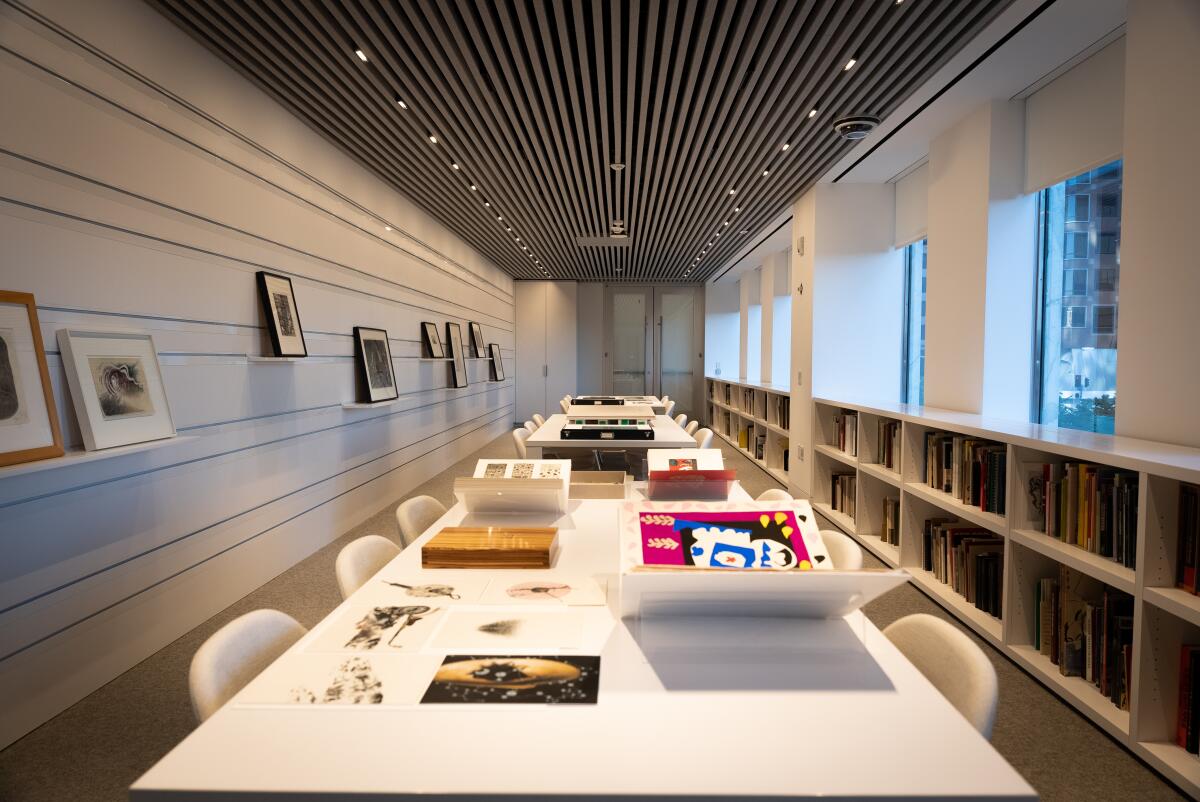
Since debuting the new study room, the Hammer has made an increased effort to draw classes from the university — not just art history courses, but those tackling health and wellness, social justice and psychiatry. Curatorial fellow Jennie Waldow combs through the university’s course catalog and reaches out to professors, citing artists and works that might fit with their syllabus. During class visits, she often gives lectures and offers supplemental handouts.
Doctors doing their residencies in psychiatry visited the center in the fall. They viewed historical depictions of incarceration, such as one by 19th century British caricaturist George Cruikshank and another by photographer Joel Snyder in the 1970s, as a way of better understanding mental illness and how it relates to the carceral system. A comparative literature class exploring concepts of health and illness looked at depictions of disease in the 1800s alongside the AIDS epidemic in the 1980s with works by Francisco de Goya, Cruikshank and David Wojnarowicz, respectively. A labor studies class studying work, social justice and arts examined a print by 20th century social realist Ben Shahn alongside Dorothea Lange’s iconic “Migrant Mother, Nipomo, California” from 1936 and Walker Evans’ photograph, from the same year, of an impoverished family in Alabama.
Burlingham says she could see the Grunwald Center also serving as a resource for young art collectors looking to hone their tastes or for Hollywood set and costume designers.
The study room is also open to members of the public, who can make free appointments to spend an hour or two with the art in an intimate setting. Museum staffers will pull specific works from storage for visitors who make arrangements in advance — a 17th century Rembrandt print? How about a 1970s artist book by Jasper Johns? Hammer staffers will lay them out and either discuss the works with guests or hang back and let visitors connect privately with the art.
The institution’s new Grunwald Center and an adjacent gallery opening this weekend seek to answer a pressing question: how to reconcile a museum’s basic preservation function with an equally important obligation for public accessibility?
The Grunwald Center was established by German émigré Fred Grunwald in 1956 with an eye toward being a resource for students and for research. Grunwald had lost his art collection, presumably to the Nazis, during World War II. He fled Wuppertal, Germany, for Los Angeles in 1939 and later used reparations money he’d received to rebuild his art collection, ultimately amassing about 3,500 prints, most of which he gave to the Grunwald. After his death in 1964, his relatives continued to give to the collection over the decades. The Grunwald also actively collects work, with 10 acquisitions funds.
The Hammer has housed, cared for and exhibited the Grunwald collection since UCLA took over operations of the museum in 1994 — both entities collect works on paper. Only a fraction of the Grunwald’s expansive works can ever be exhibited at any given time, so the study room serves as a portal into the collection, an ever-evolving, interactive exhibition space.
Many of the works in the collection were created with the intent to be reproduced in newspapers, books and other periodicals, conveying events of the day. So together, the Grunwald collection reflects a kaleidoscopic prism of history, from different points around the globe, over five centuries.
“That’s what art does,” Burlingham says. “It can be documentation, or just an idea, or fantasy. But it’s still related to our history and our world as it was and as it is. The collection serves as a deep resource for information and ideas.”
“Bridget Riley Drawings: From the Artist’s Studio” features 24 little-seen figurative and landscape works, plus 65 mostly geometric abstractions for which she is today well-known.
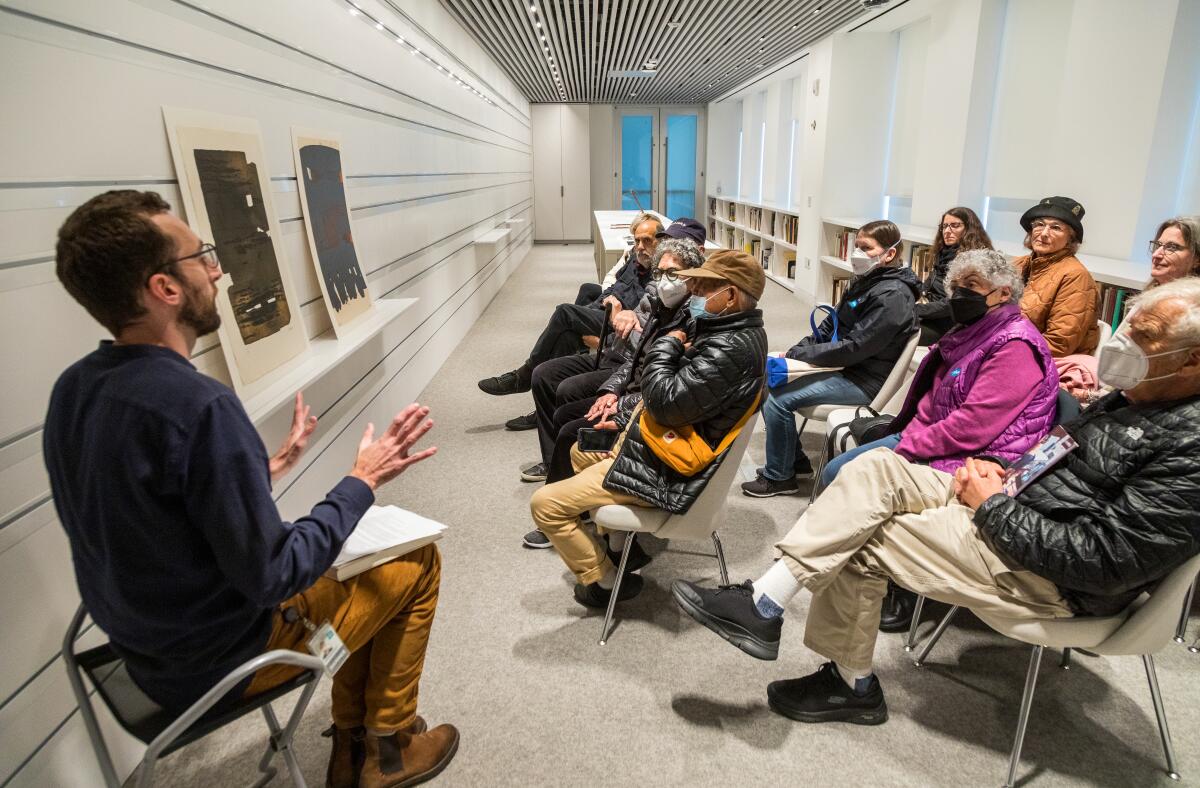
Over the years, Burlingham says, museum curators have come to compare impressions of the same print in their collections, since no two prints are exactly alike. Staff members from institutions internationally have come to peruse the collection when looking for exhibition loans. A local chapter from the National Cartoonists Society came once, in 2011, to study early cartoonists and caricaturists.
“Sometimes we get family members that come to look at a work their deceased family member had donated,” Burlingham says. “It’s very sweet. Because there are legacies that live on here.”
But the visitor experience was very different until recently. The previous two study rooms were smaller and didn’t have adequate storage — they were off the beaten path, one in a foot-trafficky administrative area of the museum and the second in a storage area. The Grunwald works were dispersed across multiple sites around the building or in off-site storage. So pulling delicate works for visitors was more time-consuming.
The study rooms themselves could accommodate fewer people and showing work was more cumbersome. Heavy, framed works were displayed on gallery walls, so that visitors could view them, but the walls had to be patched and painted afterward.
The new study room is not only larger and better lit, but the temperature- and humidity-controlled storage area is on the other side of a wall. Ninety percent of the Grunwald collection is now stored all together there, along with smaller prints and drawings from the Hammer Contemporary Collection. (Larger works from both collections are stored off-site.) And there’s room in storage for 20% expansion.
A more than 30-foot-long display wall, modeled on one in the print room at the Harvard Art Museums, has been a “game-changer,” Burlingham says. It adds display flexibility. It has built-in grooves so that narrow shelves can be configured, at varying heights, to show works of different sizes. They can be propped up unframed, and framed works can be hung from a grid with hooks. There’s also a long table that seats 18 onto which works can be laid out — the room can accommodate about 25 people. Felt strips on the ceiling help with sound absorption.
Light being the enemy of delicate works on paper, the study room has two sets of shades, translucent ones so that guests can view the works in flattering natural light for short periods of time, and blackout shades, which are drawn the rest of the time.
The museum is now working on digitizing the Grunwald collection as well as the Hammer Contemporary Collection — only a fraction of either is online — and, eventually, facilitating open hours for the study room, where visitors can just drop in.
The works-on-paper gallery has so far exhibited only contemporary pieces from both the Grunwald and Hammer collections — currently it’s showing a survey of drawings by British artist Bridget Riley — but there hasn’t yet been an exhibition there that illuminates the historical depths of the Grunwald collection.
A collection-based exhibition is now in the works, focusing on intaglio prints from the Renaissance to the present, likely to open in December.
“I thought it would be a great time to show how far back the collection goes,” Burlingham says. “Where you’re going through the early 1500s, 1600s, 1700s, but also contemporary, and how artists have been continuously using that medium.”
In the meantime, the Grunwald’s study room provides a gateway to the collection.
“Anything that’s small enough to be in this room,” Burlingham says, “you can show without having to have an exhibition.”
More to Read
The biggest entertainment stories
Get our big stories about Hollywood, film, television, music, arts, culture and more right in your inbox as soon as they publish.
You may occasionally receive promotional content from the Los Angeles Times.
